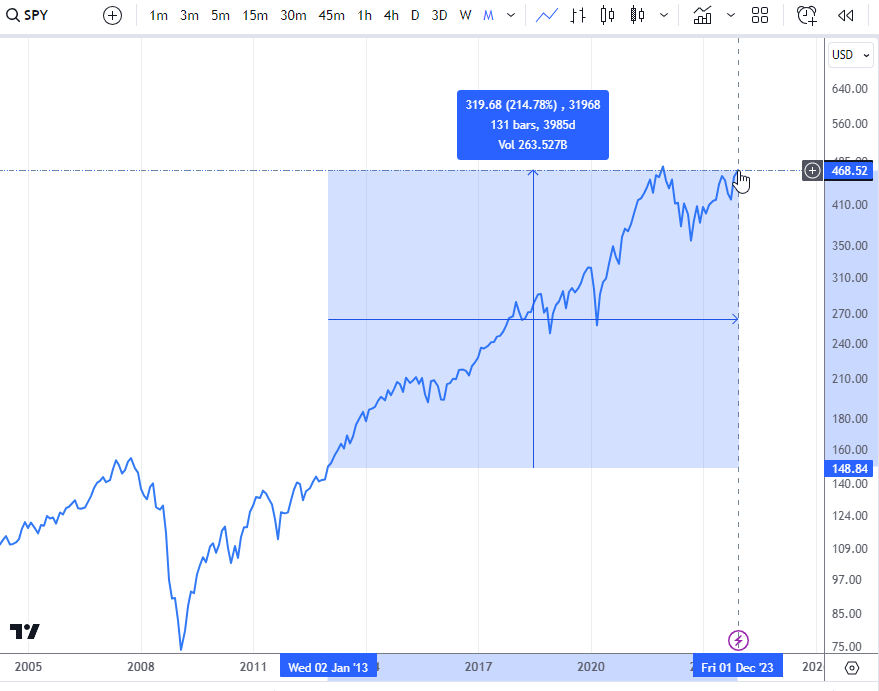4 Steps To Invest In An Index Fund
Investing in index funds is considered an inexpensive, effective way to save for old age, preserve money from inflation, and achieve other financial goals while accepting a relatively low level of risk. To invest in an Index fund:
-
Open a brokerage account
-
Define your investment goals
-
Choose your index funds
-
Invest and monitor
Determining whether to invest in index funds is a challenging decision. It hinges on your individual goals, risk tolerance, and investment timeline. However, one thing is evident: index funds present a compelling combination of benefits that can be a potent tool for many investors. This article will go through a step-by-step guide to investing in an index fund and also provide tips and the pros and cons of investing.
-
Can I buy index funds?
Yes. Disregard the notion of exclusive high-finance access – index funds are accessible to everyone. Simply open a brokerage account, and you're ready to dive in. Consider it your entry point for diverse market participation.
-
Do rich people use index funds?
Yes, from Warren Buffett to Jack Bogle, many notable figures praise index funds for their diversification, low cost, and passive management. They recognize it as a potent tool for long-term wealth-building without the complexities of active trading.
-
Is it a good idea to invest in index funds?
It depends on your goals and risk tolerance. Index funds are advantageous if you seek stable, long-term growth with lower risk. Remember the importance of diversification – spread your investments across different types of index funds to weather market uncertainties. And, as with any investment, consider your time horizon and seek professional advice if necessary.
-
Are index funds 100% safe?
No investment is entirely risk-free. While the diversified nature of index funds provides a cushion, market fluctuations can still occur. Maintaining realistic expectations and recognizing that the path to financial security, like any worthwhile journey, may encounter a few bumps along the way.
Is it a good idea to invest in index funds?
Picture a team of chefs collaboratively recreating a renowned dish by meticulously following a recipe. Similarly, an index fund operates passively, reflecting the composition and performance of a specific market index. Instead of individual stocks, the fund holds a basket of securities, providing diversification and reduced risk compared to picking individual names.
To invest in an Index fund, here are the 4 steps an investor can follow:
-
Open a brokerage account
-
Define your investment goals
-
Choose your index funds
-
Invest and monitor
1 Step 1. Open a brokerage account
Selecting the right platform is vital. Look for low fees, a user-friendly interface, and access to various index funds. Starting on your index fund investment journey requires a broker. Choosing the right broker is crucial, ensuring a seamless and efficient process.
2 Step 2. Define your investment goals
The second step is defining your investment goals. Whether saving for retirement, a child's education, or building long-term wealth, understanding your risk appetite and preference for stability or market fluctuations is crucial. This determination guides the asset allocation in your portfolio, finding the right mix of stocks and bonds.
3 Step 3. Choose your index funds
Consider broad market funds like the S&P 500 (SPY, VOO) or the Total US Stock Market (VTI) for long-term growth. Diversification is key. For income and stability, include bond index funds like US Aggregate Bond (AGG, BND). Research expense ratios (fees) and compare different funds before committing.

SPY has grown by over 200% in the last 10 years
4 Step 4. Invest and monitor
Execute purchases through your chosen platform. Periodically review your portfolio to ensure alignment with your goals and risk tolerance. Make sure to rebalance if required to maintain your preferred asset allocation.
Best stock brokers 2024
Tips on investing in index funds
When starting with index funds, consider these insightful tips to make informed and strategic investment decisions.
-
Begin small, invest regularly:
Starting with a modest investment and consistently contributing a set monthly amount through automatic deposits can be a prudent approach. This strategy leverages the power of compounding, allowing your wealth to grow steadily over the long term. -
Avoid timing the market:
The nature of index funds aligns with a long-term investment horizon rather than seeking quick gains through market timing. Attempting to predict short-term market movements can be challenging and often leads to suboptimal outcomes. Index funds thrive on capturing overall market trends over time, emphasizing patience and resilience for sustained growth. -
Consider professional guidance:
Seeking advice from a financial advisor can be invaluable, especially if you have specific financial circumstances or goals. A professional advisor can offer personalized insights and tailored strategies based on your situation. Whether you're planning for retirement, education, or wealth accumulation, their expertise can help align your investment approach with your unique financial objectives.
Pros and cons of investing in index funds
| Pros | Cons |
|---|---|
|
Low cost: Low expense ratios typically save you money on fees |
Potential for underperformance: May track the market average, potentially missing out on short-term outperformance |
Low risk: Diversification reduces risk compared to individual stocks |
No active management: No opportunity for potentially higher returns through active stock selection |
|
Diversification: Spread your risk across multiple assets and companies |
Limited control: You passively follow the index, not specific companies |
|
Passive management: No need to analyze the market or pick individual stocks |
Less excitement: This may not appeal to those seeking active trading and potentially higher returns |
|
Liquidity: Easy to buy and sell on exchanges, providing flexibility |
Exposure to market downturns: Can experience losses along with the overall market |
Summary
While index funds don't guarantee overnight riches, they offer a well-paved road toward steady, low-risk growth. Their low cost, diversification, and passive management make them ideal for long-term investors seeking stable returns without the stress of active trading. If you're looking for a reliable, beginner-friendly approach to investing, consider incorporating index funds into your strategy. Just remember, research, set realistic expectations, and be patient as your wealth accumulates over time.
Glossary for novice traders
-
1
Investor
An investor is an individual, who invests money in an asset with the expectation that its value would appreciate in the future. The asset can be anything, including a bond, debenture, mutual fund, equity, gold, silver, exchange-traded funds (ETFs), and real-estate property.
-
2
Robo-Advisor
A Robo-Advisor is a digital platform using automated algorithms to provide investment advice and manage portfolios on behalf of clients, often with lower fees than traditional advisors.
-
3
SIPC
SIPC is a nonprofit corporation created by an act of Congress to protect the clients of brokerage firms that are forced into bankruptcy.
-
4
Leverage
Forex leverage is a tool enabling traders to control larger positions with a relatively small amount of capital, amplifying potential profits and losses based on the chosen leverage ratio.
-
5
Algorithmic trading
Algorithmic trading is an advanced method that relies on advanced coding and formulas based on a mathematical model. However, compared to traditional trading methods, the process differs by being automated.
Team that worked on the article
Upendra Goswami is a full-time digital content creator, marketer, and active investor. As a creator, he loves writing about online trading, blockchain, cryptocurrency, and stock trading.
Dr. BJ Johnson is a PhD in English Language and an editor with over 15 years of experience. He earned his degree in English Language in the U.S and the UK. In 2020, Dr. Johnson joined the Traders Union team. Since then, he has created over 100 exclusive articles and edited over 300 articles of other authors.
Tobi Opeyemi Amure is an editor and expert writer with over 7 years of experience. In 2023, Tobi joined the Traders Union team as an editor and fact checker, making sure to deliver trustworthy and reliable content. The topics he covers include trading signals, cryptocurrencies, Forex brokers, stock brokers, expert advisors, binary options.
Tobi Opeyemi Amure motto: The journey of a thousand miles begins with a single step.













